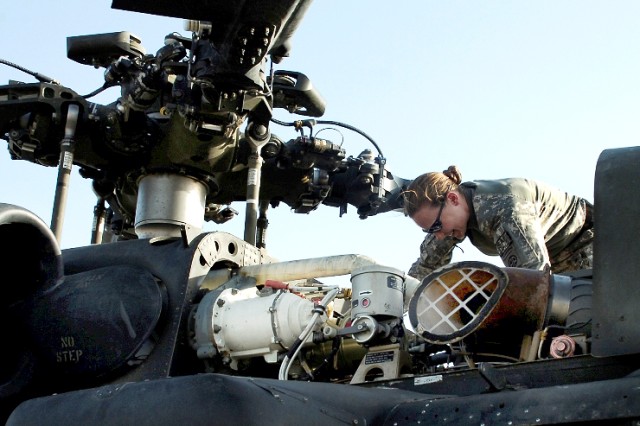KANDAHAR AIRFIELD, Afghanistan -- Women have actively supported the U.S. military since the Revolutionary War. By providing medical care to wounded Soldiers and support to their militia men, women introduced themselves as an asset to protecting the nation.
Today, female Soldiers are offered the same jobs as male Soldiers, with the exception of combat-arms careers such as infantry, armory and artillery.
Women, however, continue to deploy in support of operations Iraqi Freedom and Enduring Freedom on the ground and in the air as truck drivers, military police, field medics and Army aviation aircrew members.
Amelia Earhart and other female aviators paved the way for women in the sky in the 1920s, but it wasn't until the 1970s that female pilots were considered for U.S. military aviation programs. But serving their country from the cockpit of fixed-wing or rotary-wing combat aircraft still was not an option for women.
In 1993, then-Defense Secretary Les Aspin opened combat presence from the aircraft cockpit to women, including female-enlisted aircrew members.
In southern Afghanistan, women serve on aircrews that provide medical evacuation throughout the combat zone. Company C, 3rd Battalion, 82nd Aviation Regiment, 82nd Combat Aviation Brigade, includes men and women among its aviators and medical specialists.
"I can't think of a better job I'd rather be doing," said Chief Warrant Officer Monica Narhi, a medical evacuation pilot. "What motivates me is the significance and direct purpose in my job every day; this is a great mission."
Narhi, a 10-year Army pilot, said she has wanted to be a pilot since she was a girl. A former Army aviation officer and a veteran of operations Iraqi Freedom and Enduring Freedom, Narhi retired her commission as a captain, but continued her military career. She returned to Army aviation as a warrant officer to continue pursuing her dream to be a pilot.
In the late 1980s, the Army responded to the prohibition of women being involved in combat roles -- such as directly engaging the enemy with crew-served weapons, which excluded female helicopter pilots from the combat zone -- by using helicopters for transportation and medical evacuation.
Capt. Jennie Richey, a medical evacuation pilot, commands of the battalion's Company D. Her mission is to ensure the maintenance and operability of CH-47F Chinook helicopters. "I don't change the standards set for my Soldiers or see them different from each other," Richey said. "It doesn't matter if they are male or female, they all work hard to accomplish their missions.
"I am who I am, and I won't change how I command because I'm a female," Richey continued. "And as a pilot and member of an aircrew, we see each other as just that -- a crew; there is no difference."
Sgt. Christine Chaney, a flight medic with Company C, served in the Army for more than five years. Before joining the company, she was an emergency room nurse in Germany.
"The team provides group support to each other while on missions," Chaney said. "It doesn't matter if it's a female medic or a male medic; what matters are patients receiving immediate care."
In the combat zone, medical evacuation crews treat not only casualties of homemade bombs and gunshot wounds, but also servicemembers suffering from heat stroke or injured in accidents.
"The hardest part about being a flight medic is treating injured children," Chaney said. "My priority is treating the patient; their life is in our hands."
Chaney said she hopes to pursue her medical degree and serve in the Army as a physician's assistant or doctor.
Many women like Chaney have served in the military as medical specialists. Evacuation nurses have aided in the rescue of casualties for more than 60 years.
Lt. Elsie S. Ott, an air evacuation nurse in the 1940s, was the first woman to receive the Air Medal for her performance in support of the air evacuation mission. The Air Medal is awarded to crew members for their performance during an aviation mission in a hostile environment.
Along with flight medics and pilots, Army aviation also employs crew chiefs to assist in the maintenance and security of the aircraft. Spc. Nicole Hyde, a crew chief assigned to Company C, is responsible for helicopters' serviceability, making sure the aircraft is ready for launch when a mission is called in.
"After I've made sure the aircraft is ready, ... communication calls, engines are operational and equipment is secure, my focus is to assist the pilots and flight medic on board," she said.
Women now make up 15 percent of the Army, and working side by side with their male counterparts, have expanded their footprint in the U.S. military.


Social Sharing